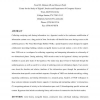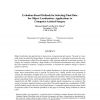2934 search results - page 556 / 587 » Hypothesis Spaces for Learning |
PAMI
2006
13 years 7 months ago
2006
In this paper, we propose two novel methods for face recognition under arbitrary unknown lighting by using spherical harmonics illumination representation, which require only one t...
TSMC
2008
13 years 7 months ago
2008
In genetic programming (GP), evolving tree nodes separately would reduce the huge solution space. However, tree nodes are highly interdependent with respect to their fitness. In th...
NRHM
2000
13 years 7 months ago
2000
Collecting, analyzing, and sharing information via a hypertext results in the continuous modification of information content over a long period of time. Such tasks will benefit fr...
APIN
1998
13 years 7 months ago
1998
Object localization has applications in many areas of engineering and science. The goal is to spatially locate an arbitrarily-shaped object. In many applications, it is desirable ...
NN
2002
Springer
13 years 7 months ago
2002
Springer
The ability to grow extra nodes is a potentially useful facility for a self-organising neural network. A network that can add nodes into its map space can approximate the input sp...


